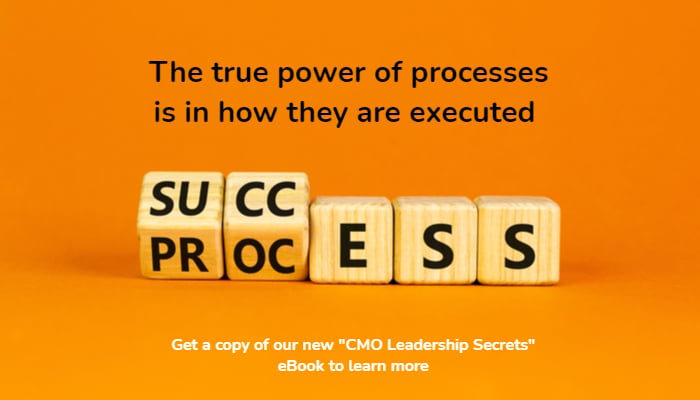When it comes to building a successful marketing team, documented processes provide an essential framework to help guide team members as they work toward departmental goals and objectives. But perhaps more importantly, processes — when done right — provide a baseline for measuring your team’s progress toward achieving your company’s vision, as well as opportunities for improvement.
--- Want the full story? Download our new eBook today: “CMO Leadership Secrets – How Marketing Directors Can Build and Grow a Successful Team”. ---
Why you need processes
Core processes allow your team to focus on delivering the elements of their work that require their knowledge, creative design and intuition (rather than having to focus too much of their time on administration, or needing to frequently “reinvent the wheel” when delivering repetitive tasks). They also make it much easier to train new team members on “how your department gets things done”.
Creating, assessing and measuring the effectiveness of internal processes is an essential part of building a successful marketing department. However, before you can do this, you must first have a set of processes in place — and make sure they are being followed.
Documenting your processes
The first step toward achieving this is defining and documenting your core processes — and in a way that is easy for everyone to follow and use. Extracting insight from those who actually carry out the work will help you capture institutional knowledge and ensure that no information is lost should a person leave your team.
To make processes easy for people to follow, they should live where the work is done (i.e. in project management systems, briefs, templates, etc.). This will ensure that people are always aware of and following them. As the marketing department, it’s important to have systems in place and integrated into your workflow so that you and your team are freed up to focus on the marketing strategy, as opposed to administrative, aspects of your work.
Be careful not to over-systematise
Systemisation fosters awareness, creates efficiencies and often leads to more creative, effective work. But it also requires a balance. Those who lean too heavily on their processes without taking time to examine how well they are working can risk overlooking opportunities for improvement.
Processes can also act as a cage that inhibits innovation or leads to an absence of critical thinking — and, at times, counterproductive and illogical decision making (“It wasn’t my fault, I was just following the process.”). Therefore, flexibility is essential, as is striking the right balance between detail, clarity and real-life usability.
At BioStrata, much of our systemisation is made possible through the power of our project management system, which we use to track all of our projects. This helps us keep track of important details, including time invested, deadlines and individual responsibilities.
The true power of processes is in how they are executed. By ensuring you have the right processes in place, and that they are understood, followed and even bent where necessary, you are creating an environment in which your team can work more efficiently and effectively to achieve your department’s goals and your organisation’s overall vision.
Download our eBook to learn more about building and developing a successful marketing team.





